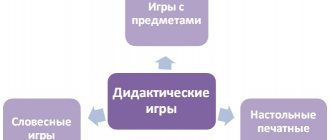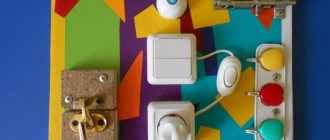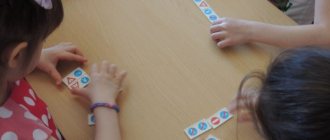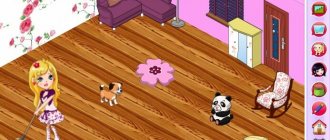Nadezhda Privalova
Didactic games for teaching sound analysis of words
Stage 1.
"How many sounds are there in a word "
Goal: development of phonemic hearing, creation of conditions for the formation in children of the skill of complete sound analysis of a word , relying on auxiliary means in the form of word .
Progress of the game.
For this game you need to have a set of cards that shows a picture and a word in the form of squares and a set of yellow squares. Children are asked to say the word (picture on card)
and determine the number
of sounds in a word . When pronouncing the word , each sound is covered with a yellow square.
Stage 2.
"Find the vowel sound "
Goal: development of phonemic hearing, teach children to conduct sound analysis of a word , find vowel sounds in a word .
Workshop: “Game techniques for developing sound analysis and synthesis skills in preschoolers”
Workshop for parents
Topic: “Game techniques for developing sound analysis and synthesis skills in preschoolers”
Target:
To assist parents in organizing work on the formation of sound analysis and synthesis in children.
Tasks:
— create a creative space for cooperation between children and parents;
— clarify and expand parents’ knowledge about sound analysis and synthesis;
- involve them in conducting sound analysis and synthesis together with children;
— involve parents in the correction process;
— give practical recommendations for conducting classes at home.
Participants:
parents with children, teachers, speech therapist and music worker.
Progress of the workshop:
Speech therapist:
Under sound analysis
understand the determination of the order of sounds in a word, the determination of the characteristics of each sound in a word.
Why do we need sound analysis? You and I use it every day, because sound analysis is at the core of the writing process.
When teaching both writing and reading, the initial process is the sound analysis of oral speech, that is, the mental division of a word into its constituent elements (sounds, establishing their quantity and sequence.
Before starting to write, the child needs to analyze the word, but already during writing, synthesis occurs, that is, a mental combination of sound elements into a single whole.
Thus, teaching writing is impossible without the formation of sound analysis. If the sound analysis is not formed or not fully formed, then children will write with errors, for example: instead of country - sana, tana, etc.
Synthesis is the joining of parts into a whole, and sound synthesis
- combining sounds into words. Sound synthesis is at the core of the reading process.
To read a word means using a combination of individual letters that reflect the order of sounds in the word, synthesizing them so that they form a real, “living” word. Full synthesis is possible only on the basis of an analysis of the sound structure of words.
If synthesis is disrupted, the child is not able to form a word from a series of sounds. For example, to an adult’s question: “What word will you get if you combine the sounds K, O, R, M?” The child answers ROMA.
The teachers of our group and I have invited you today to help you - to show how you can organize work on the formation of sound analysis and synthesis in children at home. We will teach you how to do it while playing!
We want to start our workshop with a little warm-up. Warm-ups for the articulatory apparatus and hands.
A song from the cartoon “Fixies” is playing, a speech therapist is conducting articulation gymnastics.
Today we want to involve you, parents, in conducting sound analysis and synthesis together with your children.
Progress of the game.
For this game you need to have a set of cards that shows a picture and a word in the form of squares and a set of yellow and red squares. Children are asked to pronounce the word , determine the number of sounds in the word , and cover each sound with a yellow square. And then it is proposed to say the word again and find sounds , the pronunciation of which there is no obstacle, these are vowel sounds .
Next, it is proposed to replace the yellow squares in the required cells with red ones.
Stage 3.
“What sounds are in a word ”
Goal: development of phonemic hearing, teach children to conduct sound analysis of a word , distinguish between vowels and consonants in a word .
Games that develop spatial analysis and synthesis
QUATROPALIAS (TIC-TIC-TOE)
Along with the development of spatial concepts, the game trains the child’s attention, develops logical thinking and combinatorics skills. The game is taken with some modifications from the book: A. G. Bocharova, T. M. Goreva, V. Ya. Okun “500 wonderful games”, M. 1999.
Material:
playing field 7 by 6 cells.
Number of players: 2.
Age of players:
from 6 to 15 years.
Rules of the game:
The rules of the game are reminiscent of the popular game of tic-tac-toe. Each player takes turns making a move, placing a cross or a zero in the cell, respectively. It is necessary to place four crosses or toes either vertically, horizontally, or diagonally. The player who manages to do this first wins. The game starts from any cell of the lowest line and goes up. You cannot put a cross or a zero if there is no sign already drawn under them (Fig. 4). The figure shows the winning diagonal.
yoyo55
Figure 4. An example of the playing field of the game “Quadropalia”.
We see that the game differs from “tic-tac-toe” in that the first sign is placed in the lowest cell and the further game goes from bottom to top, which allows it to be played not only on a sheet of paper, but also using a special stand with cells-cells, into which each player can throw circles or squares with crosses. This version of the game is available to preschoolers. A prerequisite is that a move must be made only where there is already either a cross or a zero under the selected cell, which not only complicates the game, but also requires a sufficient level of development of voluntary attention.
"COLORFUL SQUARE"
The game develops spatial concepts, visual-spatial memory, logical thinking (the concept of part and whole), design ability, fine motor skills, hand-eye coordination and speed of movement.
Material:
the playing field consists of 12 large colored squares, each of which, in turn, consists of various geometric shapes (Fig. 5). The number of elements forming a square determines the complexity of the task and allows it to be varied for children of different ages.
Number of players:
from 2 to 6.
Age of players:
from 5 to 12 years.
Rules of the game:
the squares are distributed among the participants in the game, everyone is asked to carefully examine it for 2 minutes, then all the components are pulled out and laid out in a mixed form on the table. After this, the child must assemble his square as quickly as possible. The first one to correctly collect a square of its color wins. For older children, you can increase the number of squares collected to two or three.
yoyo56
Figure 5. Fragment of the playing field of the game “Colorful Squares”.
ARCHIMEDEAN GAME AND HEXAMINOS
The game develops spatial, logical and associative thinking, the child’s imagination, attention, memory, hand-eye coordination, and precision of movements. The ability to gradually reduce the degree of external support creates good opportunities for the internalization of these abilities.
Material:
a set of geometric figures (triangles or n-gons). A set of pictures with subject images
Number of players:
1-3.
Age of players:
from 6 to 14 years.
Rules of the game:
The child must assemble various pictures from these parts (dog, running man, swan, scales, camel, etc.). The one who does it first wins. When creating a figure, all the details of the game are used. Therefore, if two children compete, then the details are taken from two games at once: one is “hexamino”, the other is “Archimedean game”. If a child plays alone, he gets a point for each picture he collects, and the points are doubled when moving on to a more complex task. At the end of the game, the points are counted, and the child, as it were, competes with himself.
The game provides different levels of task complexity (number of parts) and external assistance:
1. The child is asked to assemble a picture by simply superimposing the details on the image of the object with the appropriate markings (the scale of the figures and their images in the picture are the same).
2. The child is asked to perform the same operation, but on the table, looking at the picture with the necessary markings (the scale of the figures and their images in the picture are the same).
3. The child is asked to assemble an image in a picture that does not have corresponding markings, but only the general outline of the image.
4. The task is complicated by the fact that the object must be assembled on the table, having in front of you only an image with the outlined general outline of the object.
5. Completing tasks 2 and 4 with images whose dimensions do not match the dimensions of the parts.
The transition to the next level of complexity occurs only if the child has collected at least two pictures in the conditions of the previous level of complexity, without resorting to the help of elders. If you have difficulties, you need to return to performing less complex tasks.
BRIDGET
Translated from English, the name of the game means “throw the bridge.” The game is taken with some modifications from the book: A. T. Bocharova, T. M. Goreva, V. Ya. Okun “500 wonderful games”, M. 1999.
The game forms in the child concepts and visual representations of a broken line, horizontal and vertical, right angle, develops orientation in space, concentration, hand-eye coordination, and logical thinking.
Material:
a sheet of paper or a board with colored edges, with dots of two colors drawn in a certain order, corresponding to the colors of the field boundaries (Fig. 6), 2 colored pencils or felt-tip pens.
Number of players:
2. .
Age of players:
10-15 years.
Rules of the game:
two participants take turns drawing vertical and horizontal lines between two points of the same color. You cannot connect them with diagonals. Opponent lines should not intersect anywhere. One of the opponents connects the black dots with a black pencil, the second connects dots of a different color, armed with a pencil of the same color.
yoyo58
Figure 6. An example of a completed playing field in the game “Bridge-it”.
The winner is the one who is the first to build a broken line of “their own color” connecting two opposite sides of the board of “their” color. The task of each partner is to prevent such a connection, while at the same time not forgetting the main thing - to guide “their color” to victory. There is no need to be afraid of “extra” lines made for tactical reasons; there are situations when they give an advantage. The figure shows the winning path, indicated by the thick blue line.
For older children, the game can be made more difficult by increasing the size of the playing field or limiting the maximum number of moves.
"FOOTBALL"
The game forms in the child concepts and visual representations of a broken line, horizontal, vertical and diagonal, develops orientation in space, hand-eye coordination, and the ability to switch attention.
Material:
a sheet of checkered paper with a gate 10 squares in size drawn at both ends. Two colored pencils or felt-tip pens.
Number of players: 2.
Age of players:
7-12 years old.
Rules of the game:
1. Players “hit” the opponent’s goal by taking turns drawing lines on paper. The length of one “hit” is 3 cells.
2. You can hit vertically, horizontally, diagonally, describing a broken line.
3. You cannot cross “strikes” (enemy lines).
4. If the player who must walk does not have a shot option (if the other player has previously put his opponent into a dead end by trapping him with his lines, which cannot be crossed according to the rules of the game), his opponent shoots a penalty with a length of 10 cells (vertically, along horizontally or diagonally) with the right to intersect any move.
5. The loser is the one in whose goal the ball ends up.
In this game, children often argue about the correctness/incorrectness of the “hit”. It is advisable that the teacher would not rush to resolve them himself, giving the children the opportunity to practice effective interaction skills and helping to consider each dispute from different angles.
Losing in this game always causes very strong emotional experiences for the child, so the teacher needs to find ways to support the loser: “Look, you only have one hit left to win!” Or: “But you managed to “lock” him 2 times, etc.
FOUR COLORS
The game forms in the child the concept of conjugate areas of space, various geometric shapes, develops imagination and hand-eye coordination.
Material:
a sheet of paper and 4 colored pencils or felt-tip pens.
Number of players: 2.
Age of players:
11-13 years old.
Rules of the game:
the player who begins the game draws some area (outlined by a closed curve of any shape) so that his opponent can paint it with any color. Having painted, the second player draws a new one for this area and now invites the first to paint, and so on move by move, but in compliance with the rule: areas of the same color should not have common borders. The one who “requests” the fifth pencil loses, i.e., cannot comply with the coloring rules due to the position in which the opponent placed him.
2.3.3. Games that develop visual representations of geometric shapes and mathematical symbols
TRIANGLES
The game forms in the child the concept of a triangle and its constituent elements, consolidates the visual image of a triangle, creates basic drawing skills, and develops hand-eye coordination.
Material:
a sheet of paper or board with many dots drawn on it. Colored markers or crayons.
Number of players: 2.
Age of players:
7-12 years old.
Rules of the game:
Each player takes turns connecting two points so that the end result is triangles. The one who built the last segment, which resulted in a triangle, marks it with his sign (the first letter of the name or some number). When connecting points with segments, they must not intersect lines and selected areas already on the sheet. Also, if any point is inside the selected area, then it cannot be used in the future for the game. At the end of the game, the player who has more selected areas (constructed triangles) wins.
LOGIC TABLES
Purpose of the game.
the formation of concepts about geometric shapes, the development of associative thinking and perception of various shades of color, the general activation of the child.
Material:
small cards with images of colored objects (lemon, skirt, cobweb, house, etc.), resembling various geometric shapes and having different shades of the main color, as well as large cards, where specific geometric shapes are depicted in the top horizontal line, and in the left vertical column - the main color is indicated.
Number of players:
from 1 to 10.
Age of players:
5-10 years.
Rules of the game:
large cards and a stack of small cards face down are laid out on the table face up. Each child takes turns taking a small card, turning it over, determines what geometric figure the given object resembles, names its color and finds the corresponding cell on one of the large cards laid out. A certain time is allotted to complete each task. If a child completes a task ahead of schedule, he receives additional points; in case of delay in answering or an error, the child either receives fewer points or does not receive them at all, or penalty points are added to his account. The one who scores the most points wins. When playing with one child, competition occurs with the result previously achieved by him in this game.
GEOMETRIC MOSAIC
Purpose of the game:
formation of knowledge about geometric shapes and their properties (shape, size, etc.). The game also develops accuracy and selectivity of perception, creative abilities, design skills, and the ability to accelerate activities.
Material:
a set of geometric shapes of different sizes, as well as special cards depicting various scenes made up of these geometric shapes, for example: a landscape made up of an oval, triangles, trapezoids, rectangles, etc. (Fig. 7).
Number of players:
1-3.
Age of players:
5-14 years old.
Rules of the game:
There are several variants of the rules of this game for children of different ages.
Option 1
(for children 5-6 years old). The child must independently, as quickly as possible, select from the plot pictures all the triangles, circles, quadrangles or other shapes according to the model. The first one to complete the task correctly wins. The difficulty of the game increases the number of cards given to each child.
ёёё62
Figure 7. Game card for the game “Geometric Mosaic”.
Option 2
(for children 6-8 years old). The child must compose a picture as quickly as possible based on the model on the card from the provided set of geometric shapes. The first one to complete the task correctly wins.
Option 3
(for children 6-8 years old). The child must classify geometric shapes as quickly as possible in accordance with their size, or shape, or color, for example: select from the plot pictures all the small triangles, all the blue squares, etc. The one who is the first to complete the task correctly wins.
Option 4
(for children 9-14 years old). The child must choose only regular figures (all sides of which are equal if we are talking about n-gons), for example, an isosceles triangle, a square. Children 9-10 years old perform this based on a model, older children - only by the name of the geometric figure. The first one to complete the task correctly wins.
Option 5
(for children 12-14 years old). Children are asked to take turns figuring out which theorems can be proven by manipulating figures (for example, all three theorems of equality of triangles, the Pythagorean theorem (according to Atanasyan), the theorem on the area of a figure made up of other figures, etc.). The one who proposed the last option wins.
MAGIC BAG
Purpose of the game:
using tactile perception to form in the child such concepts as the shape and size of an object.
Material:
a bag with various three-dimensional geometric shapes made of wood. The number of items is from 5 to 12 (depending on the age of the child).
Number of players:
1-5.
Age of players:
5-12 years old.
Rules of the game:
The child is asked to determine by touch what object is in the bag. If a child finds it difficult to name an object, then he can be asked to simply describe it, and other players help him guess the name. The child pulls out the correctly identified object and takes it for himself. At the end of the game, everyone counts how many pieces they have and the winner is determined.
2.3.4. Games that develop knowledge of number sequences, mathematical terms and concepts
JOURNEY THROUGH MATHEMATICS
Purpose of the game:
expansion and consolidation of knowledge of mathematical terms and concepts. At the same time, the game trains verbal memory, ideas about the sound composition of a word and the sequence of letters in a word, and serial organization of actions.
Material:
the game does not require special material.
Number of players:
1-5.
Age of players:
5-10 years.
Rules of the game:
Players are presented, orally or in writing, with a word that denotes a mathematical concept, such as “triangle.” Participants must create new math-related words for each letter in a given word.
For example:
T - trapezoid, trajectory...
R - isosceles, radian, radius...
E - Euclid.
Y - angle, equation... etc.
Each participant takes turns naming invented words in the sequence of letters of the given word. The words mentioned should not be repeated. A child who does not find a word with the correct letter within a minute is eliminated from the game. The winner is the one who is the last to pronounce a new invented word starting with the required letter.
"FIGHT FOR NUMBERS"
Purpose of the game:
formation of ordinal counting and knowledge of numbers.
Material:
A pre-prepared table with numbers written in columns is attached to the board (Fig. 8).
| Table 1 | table 2 | Table 3 |
Figure 8. Tables for the game “fight for numbers”.
Number of players:
1-5.
Age of players:
7-11 years old.
Rules of the game:
At the leader’s sign, the children participating in the game come out to the board one after another. Within a certain time, they must find and show five consecutive numbers in a table. In this case, the time is counted using a stopwatch. Points are awarded for the answer: 0 points if the answer is given after 20 seconds; 1 point - after 15 s; 2 points - after 10 s. The one who gets the most points wins.
Game options:
who will find and show the fastest and most correctly:
a) sequentially numbers from the smallest to the largest in tables 2 and 3;
b) numbers that are 1 ten more than 50, 20, 90 and 10 in Table 2;
c) find the largest and smallest number in each table;
d) missing numbers in tables 2 and 3;
e) numbers that are repeated in Table 3;
f) numbers in table 3 that differ from each other by 1 ten;
g) numbers in table 3 that differ from each other by 3 units.
MATHEMATICAL DOMINOS
Purpose of the game:
practicing and consolidating various formulas and rules. The game develops attention and memory.
Material:
cards that are divided into two parts. In one of the parts some example or formula may be written, and in the other part the answer is given. Cards can be compiled to practice various topics that correspond to school programs and the individual difficulties of each child enrolled in remedial classes: to perform algebraic operations (+, –, •, :), to practice the multiplication table, to transform expressions, to practice abbreviated multiplication formulas, for working with fractions, for operations with powers, for operations with roots, etc.
Number of players:
2-4
.
Age of players:
9-14 years old.
Rules of the game:
All cards are distributed equally to the players, and one is laid out on the table. The players take turns one at a time. The task of each player is to find and match those examples or answers that are among their cards to the one that lies on the table. The one with the fewest cards left wins.
Progress of the game.
For this game you need to have a set of cards that shows a picture and a word in the form of squares and a set of yellow, red and blue squares. Children are asked to pronounce the word , determine the number of sounds in the word , and cover each sound with a yellow square. And then it is proposed to replace the yellow squares with red ones, where the vowel sound is , and with blue ones, where the consonant sound is .
Stage 4.
"Make a soundtrack "
Goal: development of phonemic hearing, teach children to conduct a sound analysis of a word , distinguish between vowels and consonants in a word , hard and soft sounds .
Speech therapy games to prepare children for sound analysis of words
Speech therapy games for children 4-7 years old
Games to prepare children for sound analysis of words
The games can be used for children of middle and older preschool age.
In speech therapy classes, the word being studied is most often formalized materially in the spatio-temporal sequence of the sound series. However, along with this, a word can be given for perception and analysis only by ear, for example, highlighting the sound at the beginning and end of the word. And children, as practice shows, make numerous mistakes here. In this regard, it is necessary to strengthen the preparation of children for sound analysis. The form of preparation is a variety of exercises for constructing and analyzing the composition of an object series, exercises for familiarizing children with color, shape, and size. Game "Matryoshka dolls go to a birthday party." Goal: to clarify children’s ideas about the size of objects. Familiarization with the word - the term “magnitude”.
Progress of the game. The speech therapist tells the children that today is the bull’s birthday /shows a bull figurine/. Matryoshka dolls came to visit him: one big one is Nastasya, another smaller one is Nastya, the third small one is Nastenka /the speech therapist alternately introduces doll figures of different sized dolls into the game/. “The nesting dolls brought gifts to the bull: flowers, cabbage and crackers.” The speech therapist places flowers of different sizes in front of the bull figurine and asks: “Can you guess, bull, who brought you which flower as a gift? Come on, guys, and together with the bull, we’ll think about who brought him which flower as a gift.” The speech therapist invites the children to look at the pictures: “All the flowers are beautiful, the same color - red. Only one flower is big. The other one is smaller. He's average. The third one is even smaller. It is small. All flowers are the same in color, but different in size. And the nesting dolls are also different in size: Nastasya is large, Nastya is medium, Nastenka is small. The little bull guessed: Nastasya gave the big flower. She's the biggest. Did you guys guess who gave the bull a small flower and who gave the medium one? The middle one is a little smaller than the big flower and a little bigger than the small one.” Comparing flowers by size and correlating them with nesting dolls, also different in size, serve as a model for children’s independent exercises in recognizing and choosing objects of different sizes. The speech therapist puts the nesting dolls in a row along a line, and the children place objects near each of them: large - near Nastasya, medium - near Nastya, small - near Nastenka. Thus, they determine who brought what gifts for the bull. Game "Matryoshka in the store." Purpose: to exercise children in recognizing and selecting objects of different sizes. Consolidation of words denoting quantity. Clarification of the content of the word “magnitude”. Game "Matryoshka and the bull." Goal: to clarify children’s ideas about the composition of the series. Familiarization with the words: row, place, beginning, middle, end, left, right, in front, behind, next to, first, last.
Progress of the game. The speech therapist tells the children the story of the matryoshka and bull walk. The bull got into trouble: he fell into a hole. The speech therapist offers to help the nesting dolls save the bull. The words of the story are accompanied by actions with toys. “One day, the nesting dolls - Nastasya, Nastya and Nastenka took the bull for a walk. The bull ran ahead along the path, looked around, the raven counted, did not look at his feet, and suddenly fell into a hole. Nastasya ran up to him, grabbed him by the horns, pulled him out of the hole, but couldn’t pull him out. Nastasya called Nastya /the speech therapist places the matryoshka doll Nastya on the opposite side of the bull/. Nastasya for the horns of the bull, Nastya for the tail of the bull. They pull the bull out of the pit, but they can’t pull it out. The bull is mooing, he’s in pain.” With the participation of children, the speech therapist restores the row along the line: bull, Nastasya, Nastya. Then he continues: “Nastya called Nastenka. Nastasya by the horns of the bull, Nastya by Nastasya, Nastenka by the tail of the bull.” And again he “makes a mistake”: he puts Nastenka not in a row, but on the other side. “They pull, but they can’t pull it out.” The children again help put Nastenka in her place in a row. -Where is her place? - asks the speech therapist. - Behind Nastya? - Yes, behind Nastya, behind Nastya. “Nastenka has found her place,” says the speech therapist. “She’s the last one to get up.” There is no one behind her. This is the end of the row. So we helped the nesting dolls pull the bull out of the hole. Then the speech therapist removes the figures and asks the children to remember in what order they stood behind the bull. With a gesture, pointing to the designated place, he asks: “Whose place is this? Who was the first to stand here? Who was the last? Who was at the beginning of the row? Where is the beginning of the row? Closer to the right or left hand? Etc. Children can respond to the task with a gesture, but those who begin to use the words themselves deserve approval: “row”, “in a row”, “at the beginning”, “on the left”, “place”, “first”, “last”. Game “Who left and who came?” Purpose: observation of changes in the composition of the series. Clarification and consolidation of the meanings of words: place, row. Game “Hide and Seek with Matryoshka Dolls” Purpose: Clarification and consolidation of concepts: left, right, between, first, last, in the middle. Learning to determine the position of a sound in a word by ear, and even more so graphically on a diagram, is an impossible task for a child for a long time, for example, when calling “.. at the beginning of a word...” the circle is not placed from left to right, representing the location of sounds, but vice versa , and such mistakes haunt the child for a long time, creating discomfort in the child’s mood. In this case, as an auxiliary tool, you can use table-drawings, where the head of the object depicted on this table is the beginning of the word, the body is the middle of the word, and the tail is the end of the word. Game "The Fox and the Gingerbread Man". Purpose: Determining the position of a sound in a word. Clarification of concepts: first, last, in the middle.
We recommend watching:
Speech therapy games for preschoolers Do-it-yourself speech therapy board games for kindergarten A set of exercises for preschoolers to develop the correct pronunciation of the sound P A set of articulation gymnastics for children 5-7 years old
Similar articles:
Speech therapy games for preschoolers and primary schoolchildren
DIY speech therapy games for preschoolers
DIY speech therapy games
Speech therapy game for older preschoolers
Speech therapy game for children 5 – 8 years old “Who is faster”
Progress of the game.
For this game you need to have a set of cards that shows a picture and a word in the form of squares and a set of yellow, red, green and blue squares. Children are asked to pronounce the word , determine the number of sounds in the word , and cover each sound with a yellow square. And then replace the yellow squares with red ones, where the vowel sound is . Next, children identify hard and soft consonants and replace them with blue and green squares.






